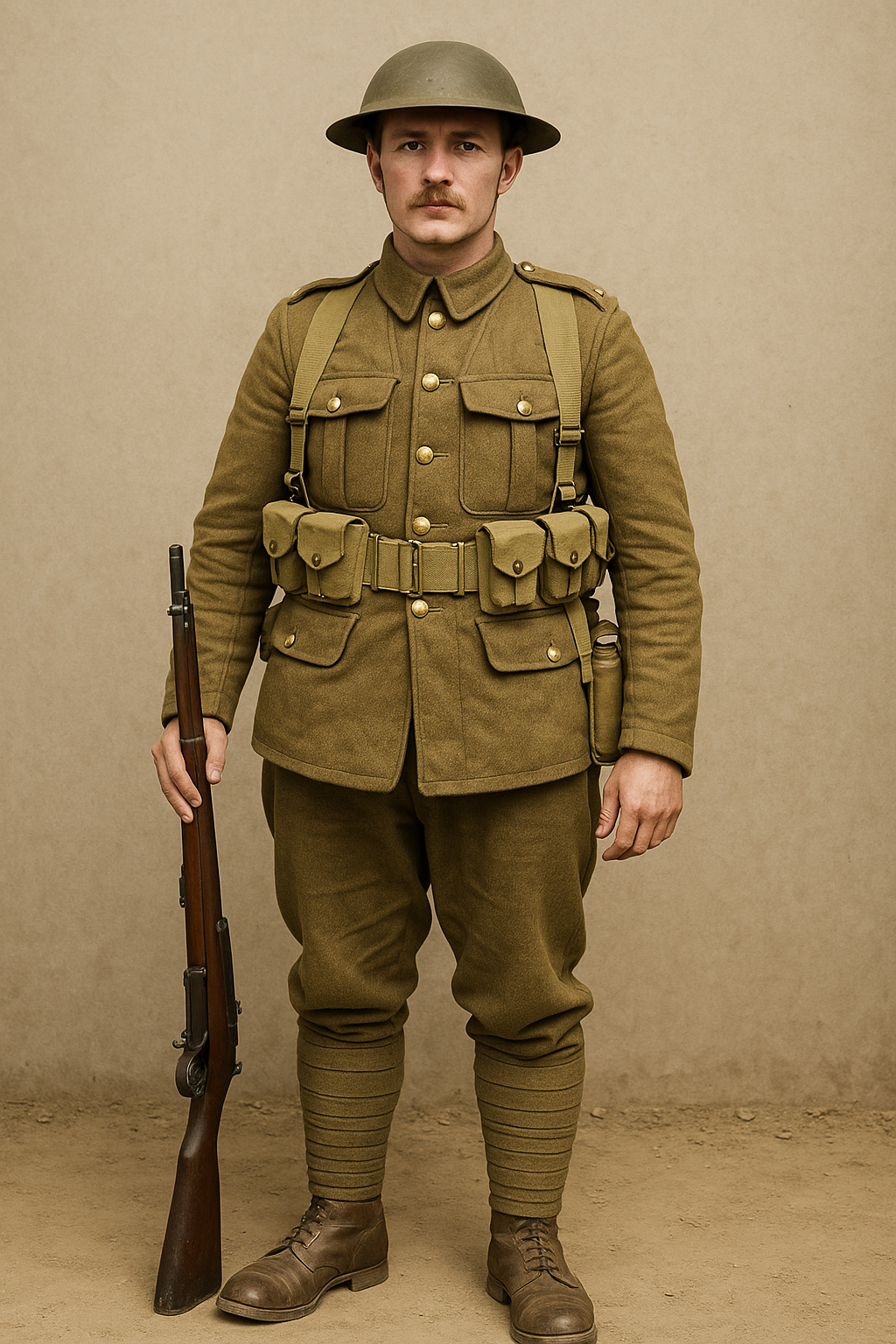
WW1 British Uniforms: A Complete Guide to First World War British Military Dress”
Published on Jul 10, 2025
🪖 WW1 British Uniforms: Guide to First World War British Military Dress
The First World War marked a turning point in military history — not only in tactics and technology but also in how soldiers were dressed. The WW1 British uniform was a revolutionary shift from the bright and elaborate designs of the Victorian era to a more practical and camouflaged look. This article dives into the First World War British uniform, exploring its evolution, components, and significance during the Great War.
🧥 The Birth of the WW1 British Uniform
When war broke out in 1914, the British Expeditionary Force (BEF) was sent to the Western Front clad in the standard-issue Service Dress uniform, which had been introduced in 1902. Unlike the colorful red coats of previous centuries, the new uniform was a practical khaki — designed to blend into muddy battlefields and provide a level of camouflage.
This uniform was worn by soldiers across ranks and units, though there were subtle distinctions based on role and regiment. The goal was simple: durability, comfort, and practicality in the field.
🪖 Key Components of the First World War British Uniform
Let’s take a closer look at what made up the WWI uniforms British soldiers wore in the trenches and beyond:
1. Khaki Service Dress Tunic
The most iconic element of the WW1 British uniform was the khaki wool tunic. Designed for durability, it had four pleated pockets, brass buttons and often featured epaulets.
- Officers had higher-quality fabrics and tailoring.
- Enlisted men wore a heavier, simpler version.
2. Wool Trousers
The matching khaki trousers were made from the same durable wool. These were tucked into puttees, which provided ankle support and protection.
3. Puttees
These long strips of cloth were wrapped around the lower leg and secured the trousers above the boots. Although they could be uncomfortable, puttees were effective in preventing dirt and moisture from entering the shoes.
4. Brodie Helmet
Introduced in 1915, the Brodie helmet became synonymous with the British soldier in WW1. Its shallow, wide-brimmed design protected soldiers from shrapnel and debris.
5. Greatcoat
During colder months, soldiers were issued a thick wool greatcoat. Heavy and bulky, it was essential for trench warfare, where temperatures could plummet.
6. Webbing and Equipment
British soldiers carried essentials using the 1908 Pattern Webbing system. This included:
- Ammunition pouches
- Water bottle
- Entrenching tool
- Small pack for rations and personal items
🎖️ Regimental Badges and Insignia
While the base uniform was standardized, individual regiments were distinguished by:
- Cap badges: Unique to each regiment or corps
- Shoulder titles: Indicated unit designation
- Rank insignia: Displayed on the sleeves or shoulders of NCOs and officers
These details were critical for identity and pride within units, especially on the front lines.
⚔️ Officer vs. Enlisted Uniforms
Though the general structure was the same, there were differences between officers and enlisted men:
FeatureOfficerEnlisted Man
Material Finer wool or cotton Coarse khaki wool
Tailoring Custom fit Mass-produced
Sidearm Revolver Rifle (e.g., SMLE)
Equipment Private purchase Government-issued
Officers often purchased their uniforms, resulting in variations in color and cut. Many even had tailor-made boots, Sam Browne belts, and privately acquired equipment.
🌍 Variations Across the Empire
The First World War British uniform wasn't limited to soldiers from the UK. Troops from across the British Empire — including Canada, Australia, India, and South Africa — wore similar uniforms with slight modifications:
- Australian “Slouch Hats” were a distinctive alternative to the peaked cap.
- Indian troops wore turbans instead of helmets or caps.
- Canadian Expeditionary Force used slightly darker khaki and variations in webbing.
Despite differences, the uniform symbolized unity across the Empire’s fighting forces.
🧼 Uniform Maintenance in the Trenches
Life in the trenches was harsh, and keeping uniforms clean was nearly impossible. Soldiers were issued spare clothing, but laundering was infrequent. Lice infestations were common, and many soldiers would boil their uniforms to kill pests.
Trench repairs also meant uniforms were often patched up with whatever materials were available. This led to a “worn but proud” look for many soldiers returning from the front.
🧵 Collecting and Reenacting WW1 British Uniforms
There’s a growing community of military history enthusiasts, collectors, and reenactors who are passionate about preserving the legacy of WWI British uniforms. Whether it’s for museum displays, educational programs, or battlefield reenactments, authenticity matters.
Paddelaters.com offers historically accurate reproductions of:
- Khaki service tunics and trousers
- 1908 webbing equipment
- Greatcoats and helmets
- Regimental badges and accessories
Each item is crafted to match the specifications used over 100 years ago, ensuring that history lives on — in fabric and form.
📜 Final Thoughts: Why the WW1 British Uniform Still Matters
The WW1 British uniform isn’t just clothing — it’s a visual symbol of courage, endurance, and transformation. The khaki tunic and Brodie helmet conjure powerful imagery of muddy trenches, silent heroism, and a world changed forever.
As collectors and historians continue to study the First World War British uniform, it remains a poignant reminder of the millions who served — and the role that even a uniform can play in shaping military history.
